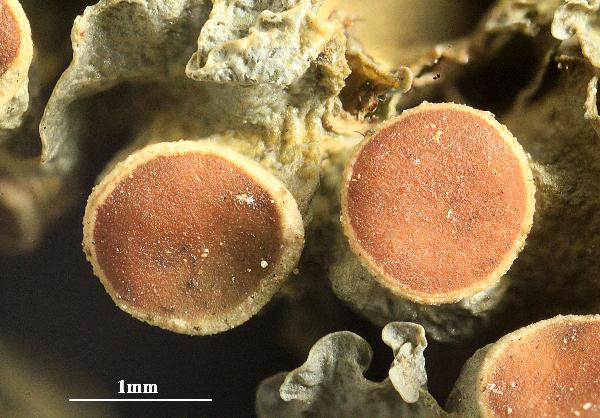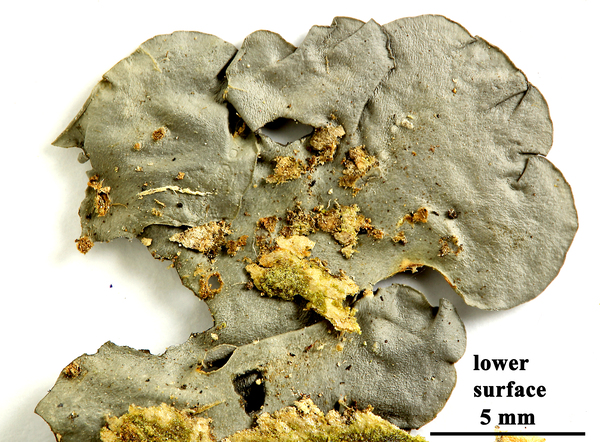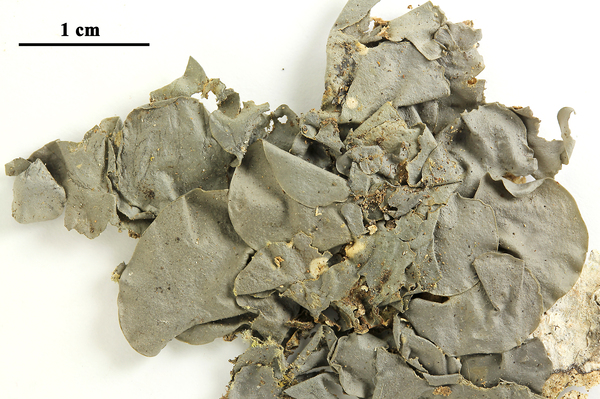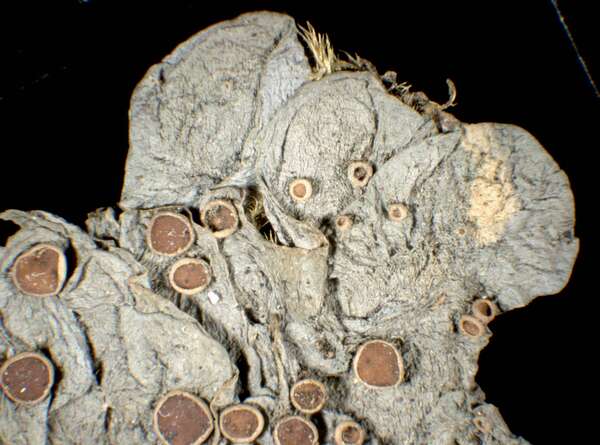Leptogium corticola (Taylor) Tuck.
in Lea, Cat. Pl. Cincinnati: 47, 1849. Basionym: Collema corticola Taylor - London J. Bot., 5: 195, 1847.
Synonyms: Leptogium cimiciodorum A. Massal.
Description: Thallus foliose, subgelatinous when wet, loosely adnate, 2-8 cm wide, the lobes irregular, elongate, flat, separate, 2-10 mm wide, up to 300 µm thick, with rotund, entire, often upturned apices, medium grey, dull, strongly and irregularly wrinkled, not isidiate,75–100 μm thick at the smooth to wrinkled areas and 150–250 μm thick at ridges. Lower surface pale grey, smooth to wrinkled, with scattered tufts of white hapters, but not densely tomentose. Upper and lower cortices consisting of a single layer of irregularly isodiametrical, 3-10 µm wide cells, the internal parts of thallus with loosely interwoven chains of Nostoc and hyphae. Apothecia common, lecanorine, laminal, sessile, 0.5-2 mm across, with a brown, concave to convex disc and an often wrinkled thalline margin. Thalline exciple euparaplectenchymatous; epithecium brownish; hymenium colourless, 90-150 µm high, I+ blue; paraphyses simple, 2-3 µm thick at mid-level, the apical cells slightly swollen; hypothecium colourless. Asci 8-spored, cylindrical-clavate, the apex strongly thickened, the apical dome K/I+ pale blue, with a downwardly projecting K/I+ deep blue tubular structure. Ascospores hyaline, submuriform, with 3-5 transverse septa and 0-1 longitudinal septa, ellipsoid to slightly subfusiform, 30-56 x 10-20 µm. Photobiont cyanobacterial (Nostoc, the cells in long chains). Spot tests: all negative. Chemistry: without lichen substances.
Growth form: Foliose, broad lobed
Substrata: bark
Photobiont: cyanobacteria, filamentous (e.g. Nostoc, Scytonema)
Reproductive strategy: mainly sexual
Most common in areas with a humid-warm climate (e.g. most of Tyrrenian Italy)
Commonnes-rarity: (info)
Alpine belt: absent
Subalpine belt: absent
Montane belt: extremely rare
Dry submediterranean belt: extremely rare
Humid submediterranean belt: extremely rare
Padanian area: absent
pH of the substrata:
1 2 3 4 5
Solar irradiation:
1 2 3 4 5
Aridity:
1 2 3 4 5
Eutrophication:
1 2 3 4 5
Poleotolerance:
0 1 2 3
Altitudinal distribution:
1 2 3 4 5 6
Rarity
absent
extremely rare
very rare
rare
rather rare
rather common
common
very common
extremely common
Loading data...
Occurrence data
Predictive map

Felix Schumm - CC BY-SA 4.0
[ABL78431], Brazil, Santa Catarina, Joinville, campus Univille, in
park on tree bark. 26°15'12'' S, 48°51'23'' W. Leg. A. Aptroot (78431),
29.03.2019, det. A. Aptroot, 2019.

Felix Schumm - CC BY-SA 4.0
[ABL78431], Brazil, Santa Catarina, Joinville, campus Univille, in
park on tree bark. 26°15'12'' S, 48°51'23'' W. Leg. A. Aptroot (78431),
29.03.2019, det. A. Aptroot, 2019.

Felix Schumm - CC BY-SA 4.0
[ABL50540], Brazil, Sena Madureira, Reserva extrativista Cazumbá- Iracema, 2 km E of Núcleo Cazumbá, on tree bark in disturbed rain forest. 09°07’ S, 68°56’ W, 170 m. Leg. A. Aptroot (no 50540), M. Cáceres & J. Cavalcante, 12.04.2019. Det. A. Aptroot. 2019.
Growth form: Foliose, broad lobed
Substrata: bark
Photobiont: cyanobacteria, filamentous (e.g. Nostoc, Scytonema)
Reproductive strategy: mainly sexual
Most common in areas with a humid-warm climate (e.g. most of Tyrrenian Italy)
Commonnes-rarity: (info)
Alpine belt: absent
Subalpine belt: absent
Montane belt: extremely rare
Dry submediterranean belt: extremely rare
Humid submediterranean belt: extremely rare
Padanian area: absent
pH of the substrata:
| 1 | 2 | 3 | 4 | 5 |
Solar irradiation:
| 1 | 2 | 3 | 4 | 5 |
Aridity:
| 1 | 2 | 3 | 4 | 5 |
Eutrophication:
| 1 | 2 | 3 | 4 | 5 |
Poleotolerance:
| 0 | 1 | 2 | 3 |
Altitudinal distribution:
| 1 | 2 | 3 | 4 | 5 | 6 |
Rarity
absent
extremely rare
very rare
rare
rather rare
rather common
common
very common
extremely common
Loading data...
Occurrence data
Predictive map

Felix Schumm - CC BY-SA 4.0
[ABL78431], Brazil, Santa Catarina, Joinville, campus Univille, in park on tree bark. 26°15'12'' S, 48°51'23'' W. Leg. A. Aptroot (78431), 29.03.2019, det. A. Aptroot, 2019.

Felix Schumm - CC BY-SA 4.0
[ABL78431], Brazil, Santa Catarina, Joinville, campus Univille, in park on tree bark. 26°15'12'' S, 48°51'23'' W. Leg. A. Aptroot (78431), 29.03.2019, det. A. Aptroot, 2019.









